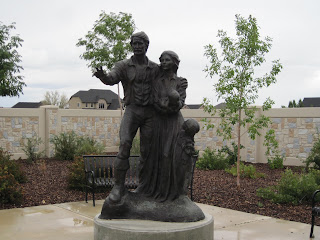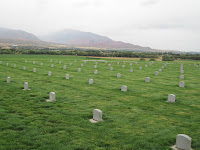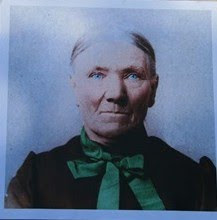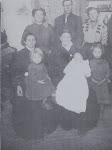 |
| Chief Washakie 1865 |
"Washakie told his people: “You must not fight the whites. I not only advise against it, I forbid it!” The settlers were so appreciative of Washakie’s assistance that 9,000 of them signed a document commending the Shoshonis and their chief. He was also on friendly terms with the Mormon leader “Big-Um” or Brigham Young."
Quotation from an unknown old book, apparently from an Indian in the early era:
“Buffalo was recklessly slaughtered by the white man. Buffalo was our food, shelter and clothing --
now the white man is our buffalo.”
“This source also stated that the white man gave three things to the Indian: the horse, the gun, and whiskey.
It was said that the Shoshones had been horse people since 1800 -- maybe 25 to 50 years earlier. The Indian learned to cope only with the horse. He could fight or hunt on horseback, learned to ‘lean’ so as not to expose himself to fire. But he could not learn to cope with the other two things -- guns or whiskey. He didn’t have enough ammunition to waste on practice, so few of them became crack shots; and if the gun jammed or broke he did not know how to repair it.”
_______________________________________
Source: The Bear River Massacre by Hart pp 261.
Following the events of The Bear River Massacre, two significant incidents occured that jeopardized every man, woman, and child living in Franklin, Idaho.
Typed as originally printed.
"The Drunken Indian..."
There are Four Published Versions of this incident in "The Bear River Massacre", by Hart.
This version is taken from the Trail Blazer, History of the Development of Southeastern Idaho, 1930:
(pp 305-307) Typed as Printed:
"In the latter part of September, 1864, an event occurred that nearly cost the lives of the inhabitants of Franklin. About 500 Indians that were on their way to Bear Lake, after having a fight with a band of Indians on the Platte River, camped on Muddy River bottoms, north of Franklin.
 |
Chief Washakie in front of Tepee
with members of his family |
Some of the Indians procured liquor, became drunken and rode their horses wildly up and down the town. One drunken Indian began breaking the windows in the home of George Alder, who with others had moved from the Fort by this time, north on Muddy river (* early name of Cub River, traditionally a mountain-clear stream). When Mrs. Alder remonstrated with him and tried to drive him away, he picked up a large willow stake and began whipping her and tried to trample her under his horse’s feet.
The screams of Mrs. Alder and the strange actions of the Indians attracted the attention of some men who were threshing at Samuel Handy’s place, a short distance from Alder’s. They ran to the rescue with their pitchforks. Ben Chadwick, who was feeding the threshing machine when Mrs. Alder’s screams were heard, came running up with a butcher knife in his hand, (he had been using the knife to cut the bands that bound the sheaves of wheat).
 |
Benjamin Chadwick Sr. Eldest son of
Joseph Chadwick and Mary Whitehead |
Ben gives his experience as follows:
“I ran at the Indian with my butcher knife, my only weapon; he struck my father down and continued to race after Mrs. Alder, striking her down and trying to trample her under his horse. As fast as the men came up, the Indian would knock the pitchforks out of their hands with his long club. William Handy came running up with a pistol and all the men shouted, ‘Shoot! Shoot! Shoot him!’ Handy seemed to hesitate and I said, ‘Give me the pistol! I can shoot!’ I took the pistol from his hand and shot. The Indian fell from his horse, wounded in the neck.
“My father and the other men urged me to leave immediately. I rode Wm. Davis’ horse to the home of John Lard on High Creek (* about five miles south), I disguised myself by shaving and cutting my hair. (Previous to this time Ben had worn a long beard and hair to his shoulders.) I also changed horses and came back to Franklin about 12 o’clock that night with some of the Minute Men.”
Just about a quarter of a mile east of where the Indian was shot, another scene was enacted. Robert Hull and Howard Hunt were on their way to the Indian camp at 5 o’clock in the evening, to try to recover the linsey skirt that had been stolen that morning from Mary Whitehead, by two Indian women. Not knowing what happened, Mr. Hull and his companion were watching Mr. Handy running with something in his arms. They wondered why he was running. Suddenly Mr. Hull felt someone grab him; in another moment he found himself staring into the barrel of Chief Washakie’s pistol. The Chief snapped off the trigger three times, but the gun didn’t discharge. Then he pointed away from Mr. Hull and fired. This time the shot exploded. The Indians who had immediately gathered and witnessed the scene must have thought Mr. Hull a spirit, when the Chief could not shoot him. Mr. Hull was unarmed, having left his pistol at home that noon. This was fortunate, for the Chief would very likely have been killed, and the people of Franklin would have been massacred as a result.
When Washakie grabbed Mr. Hull, Howard Hunt escaped and gave the alarm. Mr. Hull, after being dragged to the Indians camp, was surrounded by young bucks who danced about him. Squaws prodded him with butcher knives.
Chief Washakie would say: “White man killed Indian” and Hull would answer, “No!”
They continued to persecute him, the squaws joining in with their painful prodding. While Mr. Hull was surrounded by the dancing warriors and knife-armed squaws, he recalled a dream that he had had three nights before. This gave him courage to endure the torture inflicted upon him. He had dreamed that he was completely surrounded by snakes that would dart at him from different parts of the circle. One big snake came up and struck at him with its fangs three different times but didn’t touch him. None of the snakes bit him.
He asked for Chief Alma, (who could talk English). The Indian answered “Chief Alma dead, (meaning drunk), on White Man’s fire water.”
Several times during the night the Indians forced Mr. Hull to go closer to town and call for the Bishop. He knew they wanted Bishop Thomas and he could not make them understand that Bishop Thomas had moved away.
It was a bright moonlight night. The Indians saw the glittering of hundreds of fire-arms in the distance. The Minute Men were gathering and had been since 9 o’clock that night. They ceased to prod him with the knives after this.
About 11 o’clock that night Bishop Maughan, Ezra Benson, Bishop Hatch, A. Neeley and Wm. Hull went down to the Indian camp and conferred with the Indians. The Indians finally agreed to let Hull go if they would find the man who shot the Indian. (* local legends say the Indian was killed, not just wounded. Nh)
They returned from the Indian camp about 1 o’clock that morning. After Mr. Hull had greeted his loved ones, he asked about Ben Chadwick. Upon finding that Chadwick was in town, Mr. Hull found him and warned him to leave, and said, “The Indians are determined to get you.”
“I do not believe my friends will give me up to them,” said Mr. Chadwick.
Here are the words of Mr. Chadwick recalling the incident:
“William Whitehead, my wife and sister came and begged me to leave again, so I ran to the home of the Wheeler’s where I had left my horse, then made my way to Slaterville.”
 |
| Chief Washakie and tribal members |
Next morning Apostle Ezra Benson and Bishop Maughan called a meeting at 10 o’clock. The Indians, including chief Washakie and some of his braves, were invited. They were given places at the front in the bowery where the meeting was held. While speaking to the people, Bishop Maughan turned to Washakie and said, “What would you do if one of our men should go to your camp and start whipping and killing one of your women?”
Washakie answered, “We kill him!”
Bishop Maughan then said: “That is all we have done.”
Then he continued speaking to the people. “Talk about giving a man up that would save a woman’s life! If you want to give anyone up to the Indians, give the ones up that sold the liquor to them.”
To make peace with the Indians they were given oxen, flour, cheese and other food by the people of Franklin. It seemed that some of the Indians of Washakie’s tribe still had revenge in their hearts, as the following incident will prove:
About two weeks after the peace had been made with them, Mr. and Mrs. Hull were visiting with one of their relatives who lived about two blocks from the Hull home. They were asked to stay over night.
“I do not know why we accepted the invitation to stay all night,” says Mrs. Hull, “but it must have been the hand of Providence that kept us from going home that night. The next morning when we returned home, we found that the chinking had been removed from the wall and two shots had been fired where our heads would have lain. One bullet lodged in the stock of the gun that lay at the head of the bed.”
Note: Portions taken from other versions:
"Official Program, First Idaho Day, 1910": (pp 302-305) for clarification and interest: Typed as Printed.
"About a thousand Indians on a migration and hunting expedition were going through the country under the leadership of Chief Washakie. These Indians were a peaceful band and quite friendly with the whites. They camped for a short rest in the river bottoms north of Franklin and while there some of the young warriors came up town.
During the argument that took place at the peace meeting one of the finest and most picturesque examples of eloquence that is characteristic of the highest type of American savage was made by Chief Washakie.
 |
"Put Yourself in My Place"
Chief Washakie |
His theme was, “Put Yourself in My Place.” The savage brought home to the Christian the beauty of the eleventh commandment: “Do Unto Others as You Would That They Should Do Unto You”’ and his brief speech was a temperance sermon besides. He said, “Until the white man come there was no fire water, and the Indian was sober; your people sold fire water to my people and made my warrior loco (crazy). If my people had sold fire water to your braves and made them drunken, how would you feel about it? Would you like to see him shot down like a dog, because he made a fool of himself? Will the “White Father put himself in Washakie’s place?”
“Military History of Cache Valley", by Martineau: (pp 301-302). Typed as Printed.
"On September 14th, 1864, the small town of Franklin narrowly escaped destruction and massacre.
A drunken Indian endeavored to ride his horse over a white woman, and to beat out her brains with a club. To save her life the woman was compelled to seek shelter under the horse's body, though encountering thus a peril almost as deadly as that threatened by the war club of the savage.
A white man shot the Indian to save the woman, and at once the whole band of savages flew to arms, threatening death and destruction to all unless the offending white man was delivered to them to be killed. The Indians, 300 in number, seized a white named Mayberry, and for a long time threatened him with death from knives held at his throat and tomahawks shaken at his head.
..."A singular incident transpired at this time….. Just as the head chief was departing, he said to Bishop Maugham -- “We have acted badly, but we don’t want you to talk to the Great Spirit about us. Don’t tell him to do anything to us -- don’t tell him what we have done.”
The Bishop answered that he talked to the Great Spirit every day, and could not make the promise desired. The chief urged his request again and again, but being firmly denied, went his way with a downcast look. Two days afterward, the chief sent back a hundred horses they had stolen from the range, but kept about as many more stolen in the valley, saying they needed and must keep them. As by this time they were beyond pursuit, they escaped with their booty. The people were glad to get off so well and without loss of life; for had not help so quickly arrived, Franklin would have seen a desperate and bloody fight, and many must have fallen."
(Franklin's last major threat was posed by 300, 500, or 1,000 Indians) depending upon the version.
All versions are posted under "Bear River Massacre Aftermath in Cache Valley".
_________________________________
Source:
The Bear River Massacre: Being a complete SourceBook and Story Book of the Genocidal Action Against the Shoshones in 1863 and of Gen. P.E. Connor and how he related to and dealt with Indians and Mormons on the Western Frontier.
By Newell Hart (pp. 299-307)































































